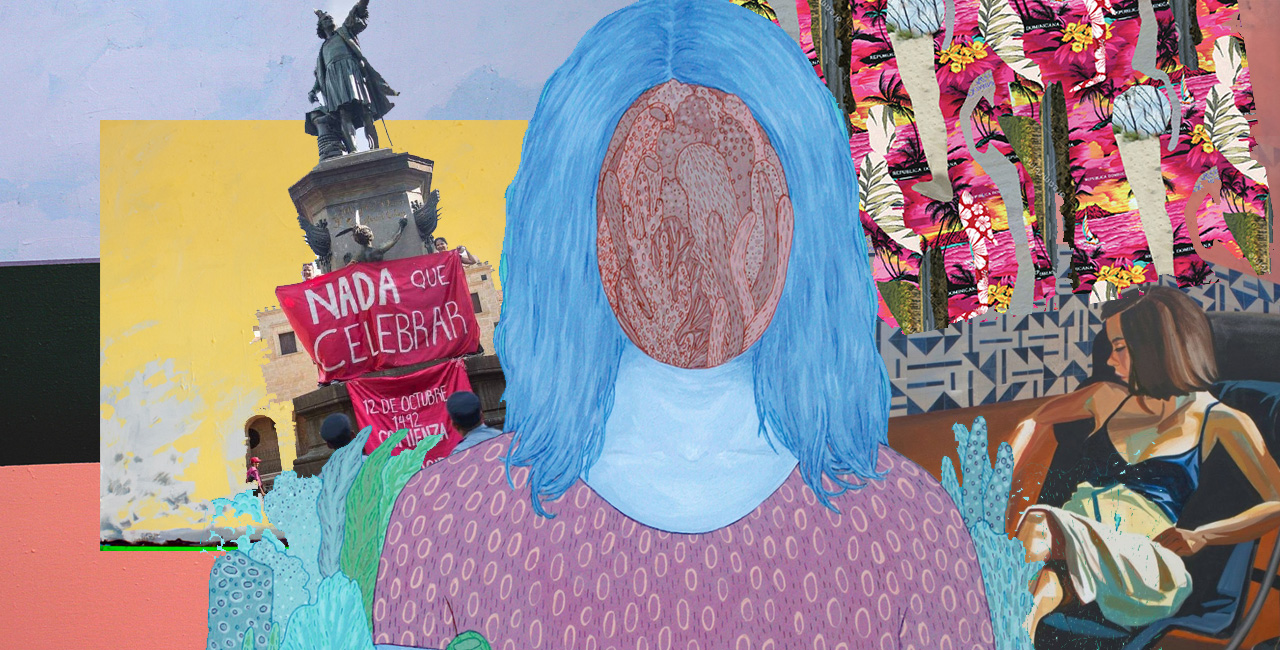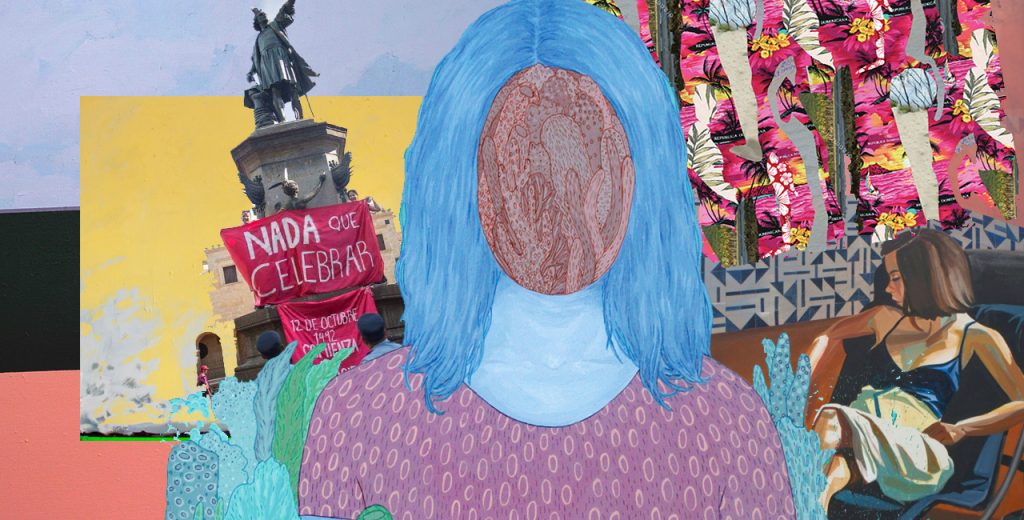The Dominican Republic, like many Caribbean countries, is sometimes considered artistically isolated, but in recent decades nation-wide initiatives have attempted to connect the island with the international art scene. In 1983, the Altos de Chavón School of Design affiliated with New York City’s Parsons School of Design, where students who complete a degree at Altos could continue their education. The Davidoff Art Initiative, founded in 2012, offers native artists residencies in Berlin, Beijing, and New York City, while private galleries, such as Casa Quien, provide the necessary platform to support an emergent class of Dominican and Dominican-American talent.
A new generation of Dominican artists is more internationally synced than ever before and coming to terms with a new era of globalization. A rise in migration trends to the United States, a feeling of displacement in far-off cities, and the ever-growing tourism industry that perpetuates stereotypes of exotic women and landscapes are common themes for these new artists.
We consulted Amy Hussein and Yina Jiménez Suriel, founder and curator of Casa Quien respectively, to distinguish 10 young artists leading the new wave of Dominican art.
1
Hulda Guzmán
Hulda Guzmán’s imaginary runs the gamut of fantastic to quotidian. Her series Injoy invites the viewers inside beautiful, minimalistic interiors that bare scenes of the everyday and the surreal. Inspired by Japanese art, her characters are often millennial couples that engage in the unabashed eroticism evoked in woodblock prints of the Edo period, while her use of wood as a canvas and the protagonism of landscapes in her frames also reveal an East Asian influence. Still, the colorful people, vegetation, and bright hues all point back to Guzmán’s life on the island.
2
Joiri Minaya
Growing up between Santo Domingo and New York, Joiri Minaya understands too well the adverse effects stereotypical representation of the Dominican Republic can have on its people. Through installation, video, performance, collage, and painting, Minaya deconstructs these exotic fantasies of the island and Dominican women. Minaya not only points out the hypersexualization and idealization of Dominican women, but also reveals the absurdity behind pop culture representations of women on the island.
In her performance Sunset Slit, Minaya dresses in a white shirt layered over a bikini and repeatedly whips her braided hair back in an underground basement. Stripped of its original context of sandy beaches and palm trees, the act loses any meaning and is exposed as a projection of a foreign gaze. Minaya also questions identity constructions, gender roles, migration, the tourism industry, and the destruction of nature.
3
Mencia Zagarella
Mencia Zagarella is a multidisciplinary artist, whose latest work Truisms of 1988 adapts the Jenny Holzer series of a similar name to the sociopolitical landscape of the Dominican Republic. Zagarella takes quotes from TV series, children’s books, and music and uses them to create placards or stencil graffiti that are installed around Santo Domingo. By placing these quotes next to other messages in public spaces, Zagarella transforms the pop culture sayings into subversive postures. In one installation, a placard with the words “No statement should be believed only because it’s made by an authority figure” is shown next to a presidential campaign ad. Her artwork usually touches on themes of freedom, education, feminism, injustice, and the environment. Zagarella is also an illustrator that draws women’s portraits.
4
Gina Goico
The Bronx-based artist counters repeated narratives about the Dominican Republic by asking the question, “What are the desires of Dominicans themselves?” This interrogation has led to a body of multidisciplinary work that encompasses installations, collages, ink drawings, and performance. In her performance piece Purga, Goico asked more than 100 fellow Dominicans to answer the question, “What would you like to purge, eliminate, or let go from your life or the island?” In other art pieces, Goico challenges foreign misconceptions of the island that include the exotic nature of Dominican women and romantic notions of island life promoted by the tourism industry.
5
Carlos De León
Multidisciplinary artist Carlos De León focuses on the economic disparities evident in the Dominican Republic. When the luxe designer brand Louis Vuitton arrived to the island in 2009, De León asked how such an exclusive store could operate successfully in the Dominican Republic where many suffer from poverty? With this question in mind, De León realized the installation El que puede, puede, which won him the top prize at the national Eduardo León Jimenes Art Contest. The installation centers a deconstructed $1,000 Louis Vuitton bag under a glass display in an attempt to answer the question how a product of thread, cloth, leather, and zippers can signify and transfer class and luxury. As part of the project, De León also questioned the distribution of resources under our current society and donated $1,000 to a female entrepreneur, who used the money to remodel her commercial cafeteria.
6
José Morbán
An accomplished graphic designer, José Morbán creates abstract renditions of indigenous artifacts and Caribbean landscapes. Taking inspiration from the pictographs of the indigenous Caribbean people, Morbán designed a set of 171 playing cards that feature fluid, symmetrical motifs that he later re-appropriated for a series of multicolored paintings. Most recently, Morbán completed a series that geometrically envisions Santo Domingo’s coastal landscapes.
7
Gabriella D’Alessandro
Gabriella D’Alessandro’s dream-like illustrations can be found in The New York Times, The Atlantic, NPR, The Washington Post, and Smithsonian Magazine. Her signature style reveals an affinity for nature and a childlike fascination with the world, demonstrated in the abundance of green pastures, colorful flora, vast skies, and curious wanderers in her illustrations. Her personal projects include Home, which draws from feelings of loss as a Dominican immigrant living in New York City and Triggered, an illustrated examination of the devastating effects human self-interest has had on the environment.
8
George Heinsen
The sculptor and painter George Heinsen considers art a fundamental tool to provoke social change. His latest installation, Cuerpxs, takes on societal ideals of the body and the detrimental effects of these pressures on the human psyche. In this interactive piece exhibited in the Eduardo León Jimenes Art Contest, volunteers choose a body part that the person feels is categorized, attacked, or discriminated. Heinsen creates molds out of these body parts and hangs them together by chains from a wine red panel. Each body part is no longer recognizable individually, encouraging the volunteers to consider Heinsen’s assertion that every body is perfect.
9
Marie Jiménez
Marie Jiménez is a multidisciplinary artist who meditates themes such as migration, gender, sexual orientation, and identity, drawing from her own experiences coming to terms with her sexual identity in the Dominican Republic. One of her earliest treatments of the subject is a series of paintings that depicted photographs taken of her and her girlfriend. The series, presented as her thesis at Altos de Chavón School of Design, would later be censored during the commencement ceremony. Since then, Jiménez has continued to tackle the subject of repression and sexuality. Al Compas is an autobiographical video that reacts to a 2012 homophobic and nationalistic article written in a magazine for kids and Cabello, a video performance, questions the male gaze and societal pressures that lead women to harm their bodies.
10
Lucia Hierro
Born and raised in Washington Heights, Lucia Hierro focuses her work on the Dominican-American experience in New York City. In her series AM New York and On That Grind, Hierro creates collages out of printed fabrics stretched out on foam to recall scenes from her current life and those from her childhood, when she grew up in a one-bedroom apartment with her mother and older brother. Hierro also challenges the exclusive nature of cultural institutions in her artwork, such as in her New Yorker and Bodega collage series. By inserting references to her Dominican heritage in her work and collaborating with her mother, Hierro asserts Dominican-Americans also have a role in the production of culture and knowledge.




